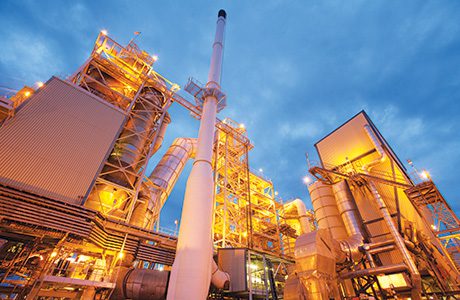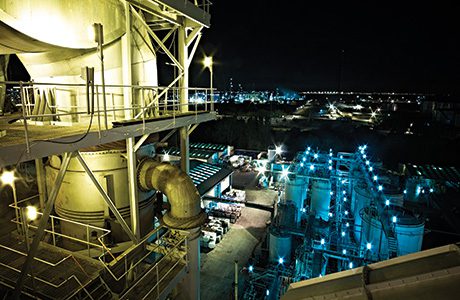
When the UK government agreed to assist with the disposal of certain Syrian chemicals in late 2013, it called upon Veolia, a UK expert in waste, water and energy environmental solutions. A showcase for high temperature incineration, the work was conducted at the firm’s facility in Cheshire, and also called for a proactive public awareness campaign.
AUGUST 2013 saw the broadcast of disturbing images of Syrian civilians who were the victims of chemical weapons (CW). Bowing to international pressure, the regime of Syrian president Bashar al-Assad agreed to give up its CW programme. Given the difficulties of destroying such chemicals within Syria itself, the UN amended the legal framework governing CW to allow the chemicals to be removed and destroyed outside Syria.
Several other countries had already ruled themselves out of the operation due to public pressure when the UK agreed – in December 2013 – to receive a consignment of the chemicals in question, known as B-Precursors, and to arrange for their destruction at UK commercial facilities.
Veolia was selected by the MoD. While the firm unquestionably had the experience and facilities for the job, the overriding issue was whether it could deliver a reputation management strategy to convince a wide range of stakeholders that the chemicals could be treated safely in the UK.
A decision was made to treat 150 tonnes of the B-Precursor chemicals at Veolia’s High Temperature Incineration (HTI) facility at Ellesmere Port in Cheshire. Working with the UK’s Foreign & Commonwealth Office (FCO), Veolia identified key stakeholders including local residents, the local workforce, the media, the council and the police, and worked to ensure they understood the level of threat posed by the materials.
B-Precursors belong to the chloroamine family, and are comparable in hazard terms to chemicals in other waste streams the firm receives routinely from the manufacture of products like agrochemicals or pharmaceuticals. Veolia set out to explain that the Syrian B-Precursor chemicals were not CW in their own right and were similar in nature to materials they handle every day. The firm also explained the chemistry of incineration.
High temperature incineration
HTI is used routinely in the disposal of hazardous materials. Veolia says it is reliable and cost effective while providing “the highest levels of safe and secure destruction” and “outstanding environmental performance”. Ellesmere Port is said to be one of the most technically advanced HTI facilities in Europe and is designed to treat hazardous, non-hazardous and low level radioactive waste materials from a wide range of industry sectors. These include bulk and drummed liquids, oily sludges, contaminated soils and powders, pharmaceutical products, contaminated packaging and materials, highly sensitive and out-of-spec products, highly toxic or reactive or malodorous materials, and low level radioactive materials.
The facility uses a water-cooled rotary kiln incinerator, which destroys wastes at temperatures of up to 1,200°C, guaranteeing 99.99% thermal destruction efficiency. Veolia says it is for “the clean and complete disposal of hazardous waste streams that can’t be sustainably recovered or recycled elsewhere”.
The kiln is supported by a shredder, an automated nitrogen blanketed system designed to improve combustion and shred a range of difficult waste streams in a variety of packages such as drums, IBCs and bulk bags. This is turned into a paste and sent to the kiln via the mixer and pumping system. It is a fully enclosed system.
The kiln itself rotates at between one and six revolutions per hour, allowing for a waste residence time of 30 – 90 minutes, “ensuring maximum burnout and volatilisation of organic materials”. The resultant slag flows continuously into a water quench in the base of a secondary combustion chamber (SCC), where it immediately cools to form an inert, glass-like solid.
The 25m-high SCC also receives exhaust gases from the kiln. Liquid wastes and air are added tangentially, creating a vortex. Separate lances then inject the aqueous, gaseous and non-compatible wastes. The residence time in the SCC is more than 2 seconds after the last injection of air. And the combination of turbulence, excess oxygen and a temperature of up to 1,200°C ensures the safe and efficient destruction and removal of all wastes.
There is also a gas cleaning and scrubbing stage, where combustion gases leave the SCC and pass through a pair of parallel gas-gas heat exchangers. These lower the temperature to around 800°C. The hot air produced at 300°C is then re-used later in the process to reheat flue gas. A water quench system then instantaneously reduces the temperature to less than 80°C. This rapid cooling – to below the critical band of 250-400°C where dioxins can reform – is an important design feature, says Veolia. It also contributes to the plant’s reported outstanding environmental performance.
Customers of Veolia are assured of compliance with the various legal obligations and corporate responsibility requirements associated with hazardous waste. The Ellesmere Port plant is authorised by the EA under the Integrated Pollution, Prevention and Control (IPPC) provisions of the 1990 Environmental Protection Act, in addition to complying with the Waste Incineration and Industrial Emissions Directives. It is also certified to the international standards for Quality and Environment, ISO9001, ISO14001 and OHSAS18001. And with an EPR10 permit, the firm can handle a full range of low level radioactive materials.
The facility at Ellesmere Port is equipped to receive 100,000 tonnes of waste solids, sludges, powders, liquids, gases and halogenated wastes. For packaged solid wastes that are ready for incineration, there is a 2,000m3 covered storage area, equipped with automated, computer-monitored conveyors that transport waste to the kiln. All of Veolia’s drum storage and drum handling facilities are protected by foam deluge systems.
A variety of purpose-built areas are available for individual waste types. These include nitrogen-blanketed liquid storage tanks protected by a water deluge system.

Communication strategy
Undertaking the chemical disposal work at Ellesmere proceeded in tandem with a careful communication strategy. This began with a series of briefings, initially with Veolia’s workforce and trade union. Unite the Union were supportive and saw potential long-term benefits of the site’s involvement in such a project.
An in-depth briefing was held with local MP Andrew Miller, assuring him of full transparency and open, honest communication. Subsequently he attended Veolia’s media day, giving his objective assessment of why he felt the chemicals were best treated at Ellesmere Port.
The firm also utilised long-standing relationships with its Community Liaison Group (CLG). This consists of local councillors, the Environment Agency, Fire and Rescue Services and residents. It delivered a presentation to the CLG, devised ‘Frequently Asked Questions’ to aid understanding and made a commitment to keeping them regularly updated.
Likewise, Veolia invited a local petitioner to a meeting providing a full explanation of the plant’s processes and gas scrubbing capabilities before a behind-the-scenes-tour. By having an open-door policy “we were able to remove the mystique of our facility and tackle misconceptions”, says Veolia.
After opening a proactive media dialogue the firm was inundated with requests from journalists wanting information, statements and interviews, answering each enquiry promptly via press releases and statements. This was then reinforced by inviting local, national and international media to site. Andrew Miller MP, the Environment Agency and the FCO all attended to simultaneously brief journalists and ensure they had the ‘whole story.’
One event was attended by the BBC, ITN, Granada, Liverpool Echo and local radio and consisted of a schedule of media briefings with interviews, filming opportunities and site tours. David Shukman, the science editor with BBC News, was offered an exclusive that resulted in balanced, responsible reporting.
The story appeared on TV news broadcasts around the world and featured on national/local radio, as well as numerous press articles. Veolia says the net result was to enhance the reputation of the chemical industry in the UK, Britain’s image abroad and the company’s expertise in the handling of hazardous waste.
Commenting on the operation, Daniel Shepherd, deputy head of the Counter Proliferation Department at the UK’s Foreign and Commonwealth Office said: “The international operation to destroy Syria’s chemical weapon stockpile was unprecedented. The UK would not have been able to make such a significant contribution had we been unable to find a willing commercial partner to destroy the chemical wastes. Veolia’s reputation management strategy and engagement was first class throughout.”
• More detail at www.veolia.co.uk






